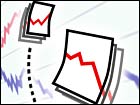|
Small (value) is beautiful
|
 |
December 3, 2001: 5:54 p.m. ET
In a rough year, small value stocks have delivered -- the trend should continue.
By Paul R. La Monica
|
NEW YORK (CNN/Money) - Making money hasn't been easy this year -- the S&P 500 is down 14 percent and the average domestic mutual fund has fallen 13.5 percent. But for the second straight year, one group of stocks has held up quite nicely -- small-cap value.
The Russell 2000 Value Index is up 5.2 percent year to date, coming on the heels of a 19.6 percent gain in 2000. And as of Nov. 30, small-cap value funds were the best-performing domestic mutual funds of the year, with a 10.3 percent return, according to Morningstar. Small blend, real estate and mid-cap value funds are the only other domestic-fund categories to have positive returns. (See table below for a list of small-cap value funds on the MONEY 100, MONEY magazine's list of top funds for 2002.)
Will the trend continue in 2002?
Small stocks are better bargains
In this environment, small caps have a few advantages over their larger brethren.
Steven DeSanctis, head of small-cap research for Prudential Securities, says that a strong dollar should help smaller stocks continue to outperform larger ones since smaller companies tend to do less business overseas. A strong dollar hurts large multinationals, since earnings in other currencies must be converted into high-priced dollars.
In addition, the lack of many initial public offerings on the horizon bodes well for small caps. In a hot IPO market, small value stocks suffer as investors chase hot new issues.
Finally, small caps are cheaper and growing faster. According to Thomson/First Call, the average price/earnings ratio for the S&P SmallCap 600 Index is 18 (based on earnings estimates for 2002), while the average for S&P 500 stocks is 21.6. Meanwhile, S&P SmallCap earnings are slated to jump 22.3 percent next year, versus just 14.6 percent for the S&P 500.
And within the small-cap arena, value should continue to outshine growth. Simply put, value stocks tend to have relatively low -- but predictable -- earnings growth. Hence the stocks trade at lower P/E ratios than the broader market. Growth stocks will outperform value stocks in boom times and value will fare better in bear markets. To that end, the Russell 2000 Growth Index plunged 22.7 percent last year and is down another 14.8 percent through November.
And small cap value stocks may continue to lead once the economy emerges from this latest downturn. "Unless the economy falls into a prolonged recession, market leadership should pass to more economically sensitive companies," says Lance James, manager of the Babson Enterprise Fund, up 21.9 percent year to date.
DeSanctis points out that many small growth stocks and technology stocks have run up sharply since the market hit its low point for the year. The Russell 2000 Growth Index, for example, is up 26.7 percent since September 21, compared to a 17.2 percent gain for the Russell 2000 Value Index. DeSanctis thinks that this rally for small growth stocks was overdone and will be short-lived and that small value stocks will once again lead the market in the beginning of the year.
Retailers and banks should shine
To play the potential out-performance of small value, James says he has been buying more consumer-oriented stocks lately, having recently added to his position in Ultimate Electronics (ULTE: down $0.42 to $25.40, Research, Estimates), a regional consumer electronics retailer trading at just 20.7 times 2002 earnings estimates despite a long-term earnings growth rate of 25 percent.
James also likes Harman International,(HAR: down $0.65 to $42.02, Research, Estimates) which makes speakers under the JBL and Infinity brands. The company has a particularly strong presence in the automobile market. The stock trades at just 14.1 times estimates for next fiscal year and earnings are expected to increase at a 17 percent clip over the next five years.
Frank Barkocy, an analyst with New York-based hedge fund group Keefe Managers, says that Keefe's small-cap bank stock hedge fund was up 34 percent as of the end of November. Barkocy thinks that small banks should continue to do well, even in the midst of the recession, since there has been increased consolidation in the sector and a lack of major credit quality concerns.
Barkocy is most bullish on banks operating in niche markets, including two California banks catering to the Chinese-American community: East West Bancorp and UCBH. Both stocks trade at a discount to their projected long-term growth rate. Earnings for East West (EWBC: up $0.22 to $22.33, Research, Estimates), based in San Marino, are expected to increase by 13 percent annually and the stock is trading at 12.6 times next year's earnings estimates. UCBH (UCBH: down $0.87 to $27.12, Research, Estimates), based in San Francisco, is an even bigger bargain, trading at 13 times earnings estimates for 2002 despite an expected long-term growth rate of 16.5 percent. 
|
|
|
|
|
 |

|

